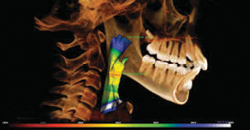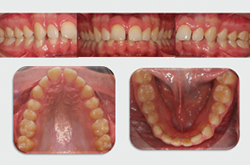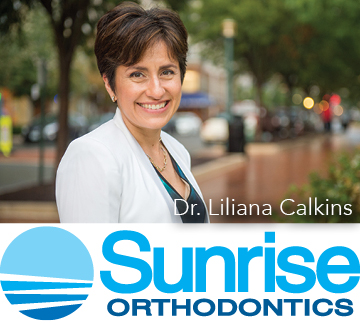Periodontally accelerated osteogenic orthodontics (PAOO) is a type of clinical procedure that combines selective incisions of the bone surrounding the teeth, bone grafting where needed, and the application of orthodontic forces (i.e. braces). This procedure takes advantage of the bone healing pattern known as the regional acceleratory phenomenon (RAP) in which more invasive dental procedures heal faster and stronger than that of lesser invasive procedures or methods. PAOO results in an increase in alveolar (dental) bone width, shorter treatment time, increased post-treatment stability, and decreased amount of apical root resorption (a ‘shortening’ of the roots of teeth associated with some orthodontic treatments).
This type of combined treatment is usually used in adult or non-growing patients to correct complex, multiple or compounded issues. It is pretty ideal as an adjunctive therapy to facilitate ideal restorative treatment for adult patients with dental implants.While most teeth respond well to traditional orthodontic forces in a matter of months, it can be a source of frustration for doctor and patient alike when the manipulation of spaces and teeth becomes stalled mid-treatment. This occurs more frequently in adult patients with fully mature alveolar bone.

More invasive corticotomies (incisions in the dental bone) combined with bone grafts and then braces, or other orthodontic appliances to guide the growth and re-shaping of the bone and alignment of the teeth, have demonstrated excellent results.
Adult patients present a special set of difficulties when it comes to orthodontic treatment. For starters, adult alveolar bone (the sockets in which your teeth sit) are very fixed
and no longer malleable. Secondly, adults more frequently experience hyalinization—a term for when tissue degenerates into a homogenous glass-like substance—when subjected to prolonged orthodontic pressures. Tooth loss can occur. Bone loss can occur. Nothing that anyone really wants!
The research team in India stated in their paper (Periodontally accelerated osteogenic orthodontics (PAOO)—a review, cited below)
“With this technique, one is no longer at the mercy of the preexisting alveolar volume, and teeth can be moved 2 to 3 times further in 1/3rd to 1/4th the time required for traditional orthodontic therapy.”
And,
“The significance of the increase of the rate of tooth movement, however, pales in comparison to the fact that the teeth can be moved two to three times further than would be possible with traditional orthodontics alone, and that the cases can be completed with an increased alveolar bone volume. This increased alveolar volume can provide for a more intact periodontium, a decreased need for extractions, a degree of facial reshaping, and an increase in the bony support for both the teeth and the overlying and soft tissues.”
With the ability to strengthen alveolar (‘tooth-bed’) bone and guide the shaping of maxillary (upper jaw) and/or mandibular (lower jaw) bone, noticeable changes can occur in the soft tissues of the lower face as well. This and similar procedures are in a very real sense tissue engineering. Patients often look different. But this is usually a very desirable result!
While PAOO is considered to be less invasive than OAO (osteotomy assisted orthodontics) or SARE (surgically assisted rapid expansion), it is still an invasive procedure (one that requires work beyond the surface) and is not without some risk. Aside from the expected, and perfectly normal, pain and swelling after the surgical portion, there have been some reports of slight interdental bone loss, loss of attached gingival tissue, and a few cases of periodontal defects observed in a small number of patients with short interdental distance. In a couple of cases of intensive corticotomies blood clots occurred under the skin on the face and neck. The vast majority of study subjects reported no problems in their treatment.
However, PAOO is not recommended for everyone. Patients with active periodontal disease or gingival recession are not good candidates for this procedure.

Photo credit: Dr. Silvana Palacios
Clinically speaking, though, PAOO is a safe and effective treatment for addressing the following issues—important to patient, orthodontist and periodontist alike:
- Resolve Crowding and Shorten Treatment Time
- Accelerate Canine Retraction after Premolar Extraction
- Enhance Post-Orthodontic Stability
- Facilitate Eruption of Impacted Teeth
- Facilitate Slow Orthodontic Expansion
- Molar Intrusion and Open Bite Correction
- Manipulation of Anchorage
The theories behind PAOO have been around for a long time—well over a century. But until recently just how to apply them effectively has been a bit of a mystery. Thanks to researchers (some of whom are cited below) there has great progress made in the development and proliferation of PAOO and other surgically aided orthodontic techniques.
So, if you are an adult who didn’t get orthodontic treatment in your youth and you wish you had, it’s not too late! You can indeed have the smile, bite and chewing action you desire. And, with these new procedures that take advantage of your body’s own healing processes (remember the RAP mentioned earlier?) you can finally have a smile to smile about in less time, with less inconvenience and much better, longer lasting, healthier results!
We want to extend our gratitude to Dr. Silvana Palacios T., Dr. Francisco Munoz T., Dr. Tom M.Wilcko for their fantastic contribution to the science of bone remodeling techniques, with their applications in orthodontics, maxillofacial reconstruction, management of cleft palate cases.
Sources:
Periodontal Accelerated Osteogenic Orthodontics: A Description of the Surgical Technique , Kevin G. Murphy, DDS, MS; M. Thomas Wilcko, DMD; William M. Wilcko, DMD, MS; and Donald J. Ferguson, DMD, MSD, Journal of Oral Maxillofacial Surgery, 2009—http://www.dentalxp.com/content/1512/5debd8f2-1bfe-4259-b435-da43fb9f60d2.pdf
Alveolar Growth Stimulated by Periodontally Accelerated Osteogenic Orthodontics , López Buitrago Diego Fernando and Benjumea Marulanda Neftali Joaquin, Universidad del Valle, Cali, Colombia; Journal of Dental and Oral Health, March 14, 2017—https://scientonline.org/open-access/alveolar-growth-stimulated-by-periodontally-accelerated-osteogenicorthodontics.pdf
Periodontally accelerated osteogenic orthodontics (PAOO) – a review , Goyal Amit, Kalra JPS, Bhatiya Pankaj, Singla Suchinder, and Bansal Parul; Dept of Orthodontics Guru Nanak Dev Dental College
Sunam, Punjab, India; Journal of Clinical and Experimental Dentistry, December 2012—https://www.ncbi.nlm.nih.gov/pmc/articles/PMC3892210/
Pictured at top:
Photo credit: Dr. Silvana Palacios

Facial and Airway Development Center
11490 Commerce Park Dr #430
Reston, VA 20191
(703) 476-3969






